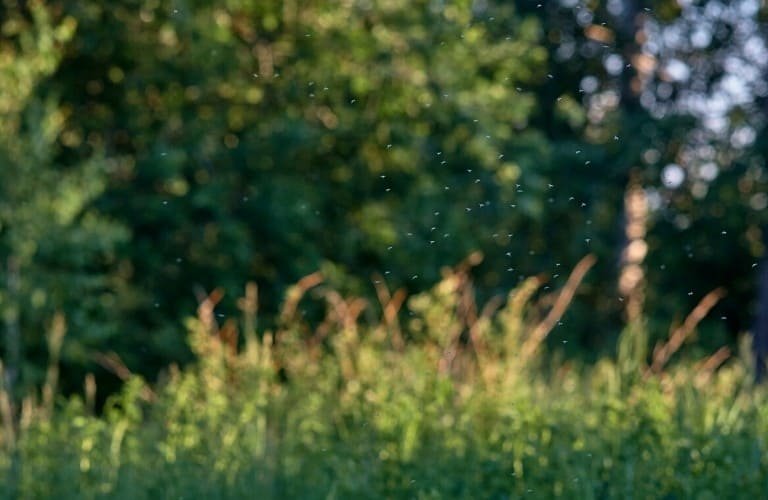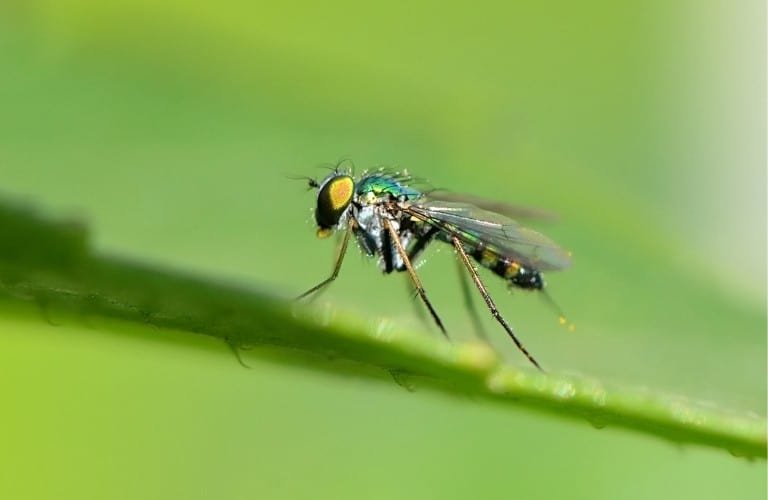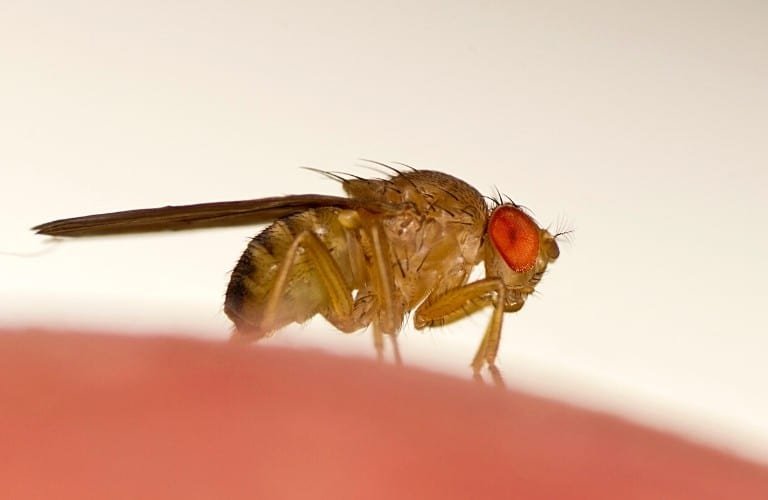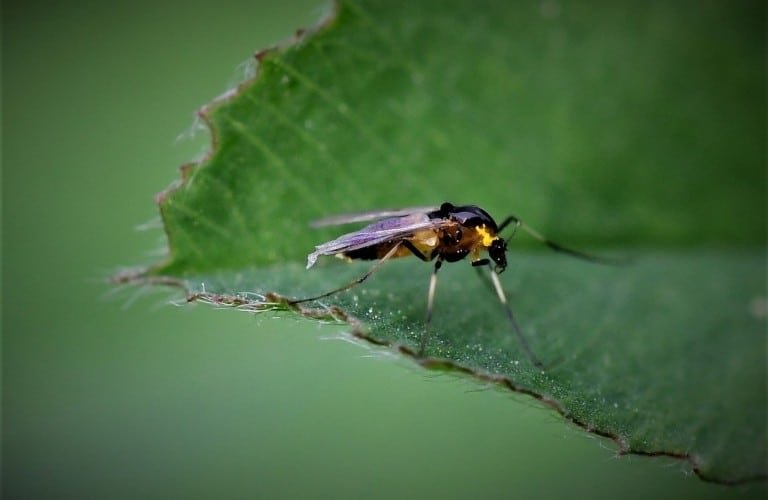At some point, you may find your home has been invaded by gnats. Gnats are defined as tiny flying insects, and they come in different varieties.
Two of the most common types are fungus gnats and fruit flies. Whatever type of gnat happens to be around, one thing is clear: they are annoying!
What attracts gnats? Gnats are primarily attracted to moisture and decaying organic matter, such as is found in damp soil and compost bins, but they are also drawn to plant roots, bright lights, sweet scents, dirty drains, damp laundry, and the sweat and carbon dioxide produced from humans.
In the following, you’ll discover what attracts gnats, learn how you can get rid of them, and understand how to prevent future infestations.
Don’t miss out on key gnat prevention and elimination tips! Check out all of our gnat articles here.
Gnats Love Moisture and Decaying Organic Matter
The reasons that gnats are so annoying and challenging to get rid of is that they multiply so quickly while they look for sources of moisture and food. This is true regardless of the type of gnat.
Additionally, some gnats can actually bite, so they don’t just annoy you and multiply freely, but they can really hurt!
Fungus Gnats
Fungus gnats are the variety that live and nest in your plants. Gnat larvae feed on plant roots in addition to the fungus found in soil.
Overly watered soil tends to produce more fungus and, in some cases, promotes root rot in plants.
These are the perfect living and feeding conditions for fungus gnat larvae.
A female fungus gnat lays her eggs on top of soil and hatches hundreds of larvae at a time.
At the very least, this will cause some damage to your plants, especially extra-sensitive indoor houseplants.
Will gnats kill the plants if left untreated? Find the answer here.
Fruit Flies
Fruit flies are those annoying little gnats you find flying around bananas left on your counter or buzzing around dirty dishes left in the sink.
You can find a detailed description of fruit flies and their habits in our article, “What Do Fruit Flies Look Like?”
A female lays up to 500 eggs at a time, typically on the surface of overripe or moist produce.
It only takes a little over one week for the larvae to reach adulthood, reproduce, and continue the cycle.
Fruit flies are not picky about where they find moisture and decomposing organic matter. Here are some of their favorite targets:
- Spoiling fruits and vegetables.
- Alcoholic drinks (beer and wine).
- Spills left on counters, tables, or stoves.
- Garbage cans.
- Sink or shower drains.
- Garbage disposals.
- Mop buckets/damp mops.
- Wet towels.
- Wet pet food.
If there are any sources of food and sufficient moisture, fruit flies and especially their larvae will feed on it. Hence, the cycle continues.
Because gnats are so small, it’s difficult to spot them on infected plants or produce you bring into your home.
Gnats may be living in a bag of potting soil used for houseplants, or fruit flies may have already laid eggs on those bananas you just bought at the grocery store.
Regardless of the exact species of gnats you’re dealing with, you certainly want them gone as soon as possible.
Head over to “How To Get Rid of Gnats” for a detailed guide on successfully winning the battle against gnats.
Outside Attractions
Many species of gnats are attracted to bright lights, which is why you’ll see them swarming around a porch light, yard lights, or a bug zapper.
In fact, most traps utilize natural gnat attractants, such as the color yellow and lights to draw gnats to the trap.
You’ll find the most highly recommended traps for gnats, in addition to effective pesticide sprays in our article, “Best Gnat Traps and Sprays.”
Gnats are mostly attracted to moist soil outdoors, especially if covered by long weeds, dead grass, or wet leaves.
Gnat larvae feed on plant roots, primarily root hairs of dead or dying plants.
They also live and nest in other moist places like compost bins, garbage/recycling containers, gutters, and wet mulch. Any source of leaking or standing water will attract gnats.
You will find gnats in flower gardens, vegetable gardens, and around fruit trees and bushes.
Oftentimes, you’ll also find gnats relentlessly swarming around your head, often the instant you step outside.
We explain why gnats are so attracted to people’s heads in this article.
Inside Attractions
Gnats, especially fruit flies, are often found indoors. They can easily gain entrance in a variety of ways (this article tells you how), and once they’re in, they will “bug” you relentlessly.
In the Kitchen
Fruit flies can primarily be found in the kitchen because there is so much potential nourishment for them there.
The kitchen is warm when the stove is used. There is also a constant source of water in the sink and drains.
Bananas left on the counter are a particular favorite of the fruit fly, as is any fruit or sweet item left out on the counter.
Here are some items and areas in the kitchen that attract fruit flies:
- Beverages.
- Overripe fruit.
- Coffee grounds.
- Crumbs.
- Dirty sinks.
- Garbage disposal.
- Spills.
- Trash cans.
How to Prevent Gnats in the Kitchen
- Clean sink drains with a drain cleaner often (this one cleans in under one minute and is safe for septic systems).
- Wipe up spills and crumbs immediately and disinfect counters frequently.
- Clean garbage disposal frequently (this foaming disposal cleanser from Amazon smells lemony fresh and can be safely used weekly).
- Empty your garbage can(s) and clean with a disinfectant.
- Fix leaky drains and pipes.
- Avoid leaving fruit or food on counters.
- Grow fresh herbs such as eucalyptus, peppermint, basil, lemongrass, or lavender as fruit flies don’t like the smell.
- Avoid leaving dirty dishes in the sink.
- Avoid leaving dirty, damp dish towels laying on counters.
In the Bathroom
Although not as popular a spot as kitchens, it’s common to find gnats in the bathroom.
Gnats are attracted to the humid temperatures after a hot shower, sweet-scented hair products, and of course, the moisture found there.
There are other areas that attract gnats to the bathroom as well.
Drains
The black gunk that tends to accumulate in sink and shower drains is another place you will find gnats.
The gunk is a combination of hair, oil, and black sludge that forms over time.
Fruit flies love the humid conditions found frequently in bathrooms, but you may also find drain flies, which are the ones that thrive in dirty drains.
Gnats also fly around leaky pipes under the sink so if you find gnats flying out from under the sink, check your plumbing.
Plants
Many people steam ferns and other plants in the bathroom or keep live plants there to add a homey touch.
Fungus flies are attracted to moist soil, and females hatch eggs there, which can very quickly result in an infestation.
Hampers
Damp clothes and towels attract gnats. Gnats can be found living and breeding in the dark, damp conditions frequently found in hampers.
Garbage Cans
Wet, decomposing, smelly trash or otherwise moist conditions in a garbage can is another source of attraction for gnats.
How to Prevent Gnats in the Bathroom
Keep drains in the bathroom clean and clear by using a drain cleaner or bleach followed by a hot water rinse.
- Fix any plumbing issues, and check faucets for leaks and dripping water.
- Remove steamed plants from bathroom as soon as possible and use a gnat trap, like these pretty yellow traps to avoid houseplant infestations.
- Dry all washcloths and towels on a towel rack (this one features six swiveling arms) to avoid throwing damp laundry in the hamper.
- Empty garbage cans frequently and clean with bleach or a disinfectant.
In the Basement
Damp, humid conditions in the basement attract gnats. Here are areas you’ll likely spot them once they come inside.
Drains
Standing water in floor drains and dirty drains in basement showers and laundry tubs are a source of moisture and provide favorable conditions for gnats to live and reproduce.
Sinks
The hair, dirt, and grease that causes clogs in basement sinks is a breeding ground for gnats primarily due to the constant moisture found there.
Wet laundry/towels
Many homes have laundry facilities in the basement, and where there is damp laundry, there is a potential to attract gnats.
How to Prevent Gnats in the Basement
- Keep floor drains clean by adding a drop or two of Dawn Dish Soap periodically to keep water levels low and drains clean from sludge.
- Keep sinks and drains clean and clear by disinfecting with bleach and a hot water rinse. The hot water typically kills gnats on contact.
- Remove standing clogs from the sink and keep on top of drains that are prone to clogging (Liquid Plumr is great for this). It may be necessary to call a plumber if clogged drains persist.
- Dry all towels before putting in a laundry basket or hamper.
- Don’t leave piles of wet, muddy, or otherwise damp laundry laying in separated piles on the floor.
Humans
Yes, even humans attract gnats. Here’s how:
- Sweat – Gnats are attracted to the scent and dampness of human sweat, which is generated in hot and humid conditions (natural gnat attractants). The more you sweat, the more gnats you attract.
- Other Body Moisture – They are also attracted to tears and any moisture coming from the nose or eyes.
- Personal Hygiene Products – Fruit or sweet-scented hairspray, body lotion, perfume, essential oils, and even some laundry soaps can attract gnats. They’ll fly around your hair and face no matter how much you swat at them.
- Breath – Gnats are attracted to the carbon dioxide which is found in human breath when exhaling. They are also attracted to bad breath.
How to Keep Gnats Away from Humans
- Wear a strong antiperspirant and breathable clothing to keep sweating to a minimum.
- Wear a hat to deter gnats from flying around your face.
- Avoid wearing sweet or fruity scented hair care products and perfumes.
- Keep mouth and teeth as clean as possible by brushing, flossing, and using mouthwash.
- Dab vanilla oleoresin or vanilla extract on pulse points as they hate the smell.
Summing It Up
Keeping conditions as clean as dry as possible are the secrets to keeping gnats away.
By eliminating sources of excess water, moisture, and humid conditions, you can help keep the gnat population down both inside and out. Here are some other tips:
- Running a dehumidifier (this one on Amazon can remove a whopping 5 gallons of moisture a day) in high moisture areas in your home helps eliminate extra moisture in the air.
- Set up DIY gnat traps using apple cider vinegar and dish soap left in a covered container with holes in the lid helps catch gnats.
- Use special traps for plants and try hanging sticky traps in other areas throughout the house.
- There are also safe-for-indoor-use insecticides you can use that will help kill gnat larvae, which will eliminate your infestation problem.
Killing adult gnats is one thing, but if you don’t kill the eggs and larvae, it will take that much longer to eliminate an infestation.
You can find more helpful tips like the ones above as well on strategies to rid gnats from your home and yard in our other gnat-specific articles. Click here for more.





